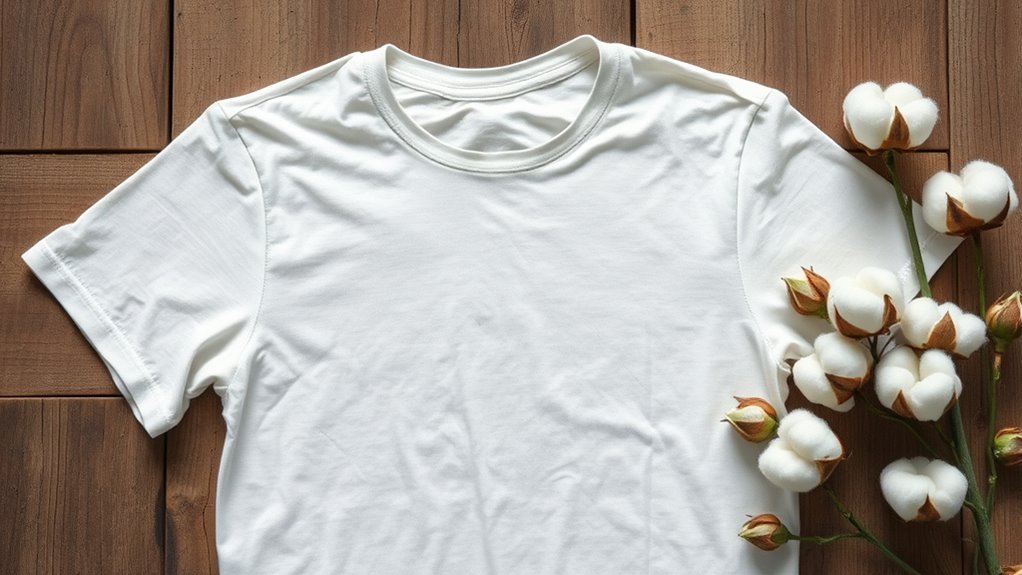Choosing high-quality, sustainable T-shirts helps the planet by lasting longer and reducing waste. Eco-friendly fibers like organic cotton or recycled polyester need less water and energy, cutting down pollution from production. Durable shirts stay in good shape longer, meaning fewer replacements and less landfill waste. Responsible manufacturing using clean processes further minimizes harm. If you keep exploring, you’ll find how your choices can make a real difference for our environment.
Key Takeaways
- High-quality t-shirts last longer, reducing the need for frequent replacements and minimizing textile waste.
- Durable materials decrease resource consumption over a t-shirt’s lifespan, lowering environmental impact.
- Well-made t-shirts are easier to recycle or repurpose, supporting a circular economy.
- Buying quality encourages brands to adopt sustainable manufacturing practices, benefiting the planet.
- Longer-lasting t-shirts reduce demand for fast fashion, decreasing pollution and resource depletion.

Have you ever wondered what happens from the moment a T-shirt is made to when it’s discarded? The journey starts with the selection of sustainable materials, which play a vital role in reducing environmental impact. Instead of conventional cotton or synthetic fibers, many brands now opt for organic cotton, recycled polyester, or hemp. These materials require less water, fewer pesticides, and less energy to produce, making the initial step more eco-friendly. By choosing sustainable materials, you’re supporting a more responsible approach to resource use and helping to minimize pollution and waste from the outset.
The manufacturing process is where a lot of environmental concerns come into play. Traditional manufacturing often involves water-intensive dyeing, chemical treatments, and energy-hungry machinery that emit greenhouse gases. However, more brands are adopting cleaner, more efficient manufacturing methods. These include using low-impact dyes, recycling water during production, and utilizing renewable energy sources. When you buy a T-shirt produced with a conscious manufacturing process, you’re encouraging companies to prioritize sustainability. This shift not only reduces the carbon footprint but also decreases pollution and waste generated during production.
As the T-shirt moves through its lifecycle, factors like durability and quality become essential. A well-made, high-quality T-shirt is designed to last longer, reducing the need for frequent replacements. This means fewer T-shirts end up in landfills, which is critical given the fast fashion industry’s contribution to textile waste. When you invest in quality, you’re making a choice that benefits the planet by decreasing demand for new resources and cutting down on waste. Plus, a durable T-shirt often feels better and maintains its shape and color longer, providing more value and satisfaction for you.
At the end of its life, a T-shirt made from sustainable materials can often be recycled or repurposed more easily than one made from synthetic or non-recyclable fabrics. Some brands now offer programs to take back old T-shirts, turning them into new products or fibers. This closed-loop approach helps keep textiles out of landfills and promotes a more circular economy. Additionally, choosing recyclable fabrics can enhance the overall sustainability of your wardrobe. By choosing to buy higher-quality, sustainably made T-shirts, you’re taking a step toward reducing waste and supporting a more sustainable fashion industry.
In the end, your choices matter. Opting for T-shirts made from sustainable materials and produced through responsible manufacturing processes not only benefits the environment but also encourages brands to prioritize eco-friendly practices. The lifecycle of a T-shirt isn’t set in stone; it can be shaped by the decisions you make as a consumer. Every purchase is an opportunity to support a cleaner, healthier planet.
Frequently Asked Questions
How Can I Identify a Truly High-Quality T-Shirt?
To spot a high-quality t-shirt, check the fabric durability and weight. A sturdy fabric feels substantial and holds its shape after washing, indicating good durability. Look for a heavier fabric, which usually suggests better quality because it’s more durable and long-lasting. Feel the material; it should feel soft yet firm. Avoid thin or flimsy shirts, as they tend to wear out quickly. Prioritize these signs for a lasting, well-made t-shirt.
What Are the Environmental Impacts of Different T-Shirt Materials?
Imagine finding out that your T-shirt’s material impacts the planet more than you thought. Cotton farming uses huge amounts of water and pesticides, harming ecosystems, while synthetic fibers, made from fossil fuels, contribute to microplastic pollution. Choosing organic cotton reduces environmental damage, but synthetic fibers shed tiny plastics in washes. You can make a difference by selecting eco-friendly materials, helping protect our planet one shirt at a time.
How Does Washing Affect a T-Shirt’S Lifespan?
Washing your T-shirt impacts its lifespan considerably. Using high washing temperatures can weaken fibers, causing it to wear out faster. Avoid fabric softeners, which can break down the fabric over time, reducing durability. Instead, wash with cold water and gentle cycles to preserve your T-shirt’s quality. Proper care helps your T-shirt last longer, saving you money and reducing environmental waste by lowering replacement needs.
Are There Sustainable Options for T-Shirt Dyes?
Think of eco-friendly dyes and natural coloring as the vibrant, sustainable paint on your shirt’s canvas. You can choose brands that use organic or plant-based dyes, reducing chemical runoff and pollution. For example, some companies use indigo from local plants, turning your t-shirt into a natural masterpiece. These sustainable options help protect the environment while keeping your wardrobe colorful and eco-conscious, making your fashion choices more meaningful.
What Are the Best Ways to Recycle or Repurpose Old T-Shirts?
When it comes to recycling or repurposing old T-shirts, you have plenty of options. You can try upcycling ideas like turning them into cleaning rags, tote bags, or even art projects. If you’re not into DIY, donation options are a great way to give your T-shirts a second life, helping others and reducing waste. Both methods extend your T-shirts’ usefulness, benefiting the environment and supporting your community.
Conclusion
By choosing quality, you extend your T-shirt’s life and reduce waste, making a real difference. Think of it as wielding a lightsaber against pollution—powerful and precise. Every time you opt for durability over cheap fabric, you’re fighting the good fight for our planet’s future. So, next time you shop, remember: your choice echoes through time, much like the timeless tales of King Arthur—proving that even small acts can shape a better world.









